NVIDIA's GeForce 8800 (G80): GPUs Re-architected for DirectX 10
by Anand Lal Shimpi & Derek Wilson on November 8, 2006 6:01 PM EST- Posted in
- GPUs
AA Disabled Performance
Up to this point, most of our benchmarks have been run with 4xAA, as we feel most people considering something like the new 8800 GTX are going to be interested in image quality as well as performance. If you don't care about antialiasing, the need for such fast graphics cards trails off quickly, as you'll see here.
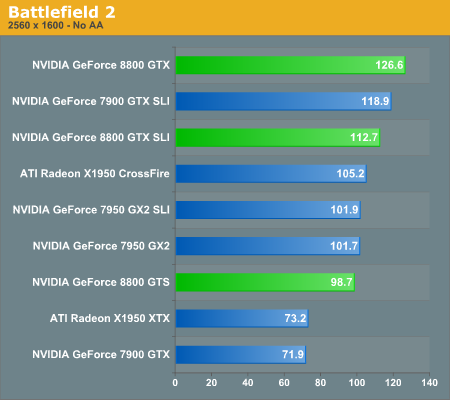
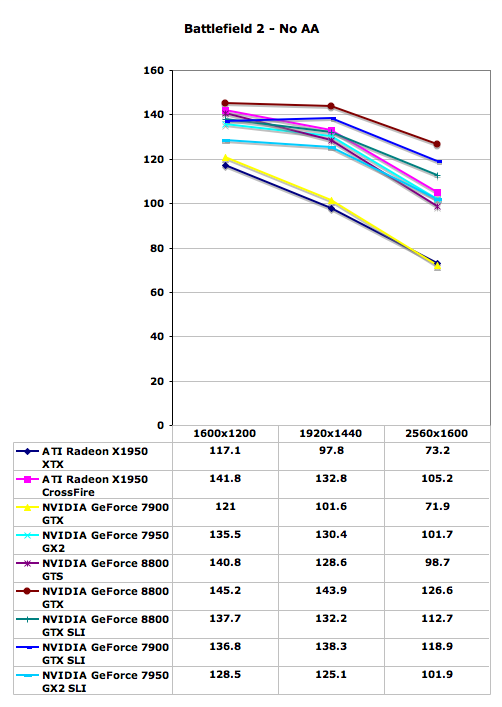
The 8800 GTX SLI still has issues with Battlefield 2, but more importantly you see the clustering of all of the high-end graphics configurations once antialiasing is disabled. Discounting the single ATI X1950 XTX and GeForce 7900 GTX cards, the spread among all the cards is about 20%-25%. Battlefield 2 is also clearly beginning to run into CPU limitations, with many of the cards showing very little in the way of performance drops when going from 1600x1200 to 1920x1440. When 8800 GTX SLI is fixed, we expect to see a more or less flat line throughout resolution scaling. Battlefield 2142 would once again be something nice to test, as frame rates are a bit lower with that title, but overall the Battlefield series has always been pretty demanding when it comes to CPU power (not to mention have enough memory).
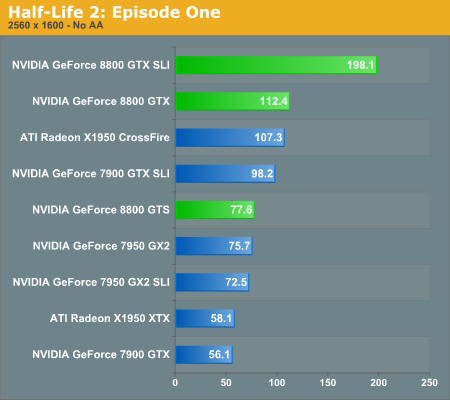
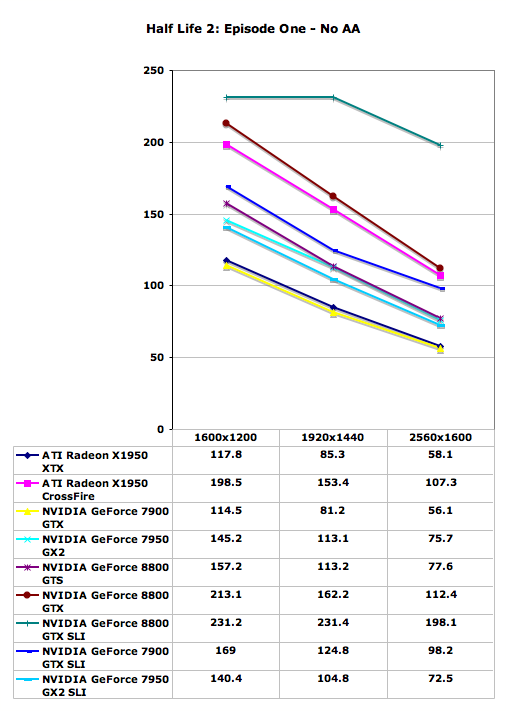
With 4xAA, Episode One showed a bit more separation, and our particular demo seemed to be CPU limited to around 230 FPS. Disabling antialiasing shows that 230 FPS is indeed where our CPU tops out. The other cards move closer to this mark, but without dropping to a lower resolution none of them are yet able to reach it. With the minimum score coming in at 56 FPS, and even then only at 2560x1600, Half-Life 2: Episode One does not appear to really need anything faster in the GPU department just yet.
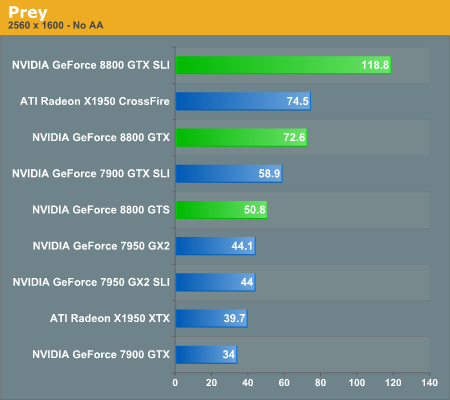
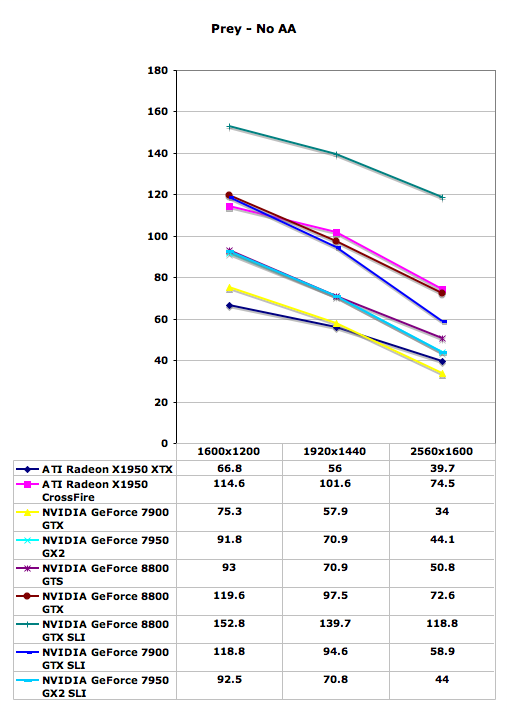
Disabling antialiasing in Prey improved performance in most of the tested configurations by about 20%, and the 8800 GTX SLI setup becomes a bit more CPU limited.. The relative positions of the cards don't really change much, although the GeForce 7 series cards appear to do slightly better without antialiasing compared to the ATI cards.










111 Comments
View All Comments
JarredWalton - Wednesday, November 8, 2006 - link
They did the same thing with the original Halo, porting it (and slowing it down) to DX9. MS seems to think making Halo 2 Vista-only will get people to upgrade to the new OS. [:rolls eyes:]stmok - Wednesday, November 8, 2006 - link
How else are they gonna get gamers to upgrade to Vista? :)(by cornering them into adopting Vista, using DirectX 10.0)
Its sad and pathetic at the same time.
DirectX 10.0 should be a "transitional" solution...That is, it covers both XP and Vista. This allows people to gradually upgrade their hardware, and if they wish, to Vista. What MS is doing now, is throwing everyone (developers and consumers) into the deep end, and expecting them to pay for the changes. (I suspect some would be put off by this, while the majority will continue to accept it...Which is unfortunate).
Great article BTW. Interesting to see the high-end stuff...But I doubt I can afford it in this lifetime!
I have two questions!
(1) Any chance of looking at a triple video card setup?
(I saw a presentation slide which had 2 video cards in SLI, while a third showed something else on screen).
(2) Any idea when the GF8600-series comes?
(mainstream market solution).
yyrkoon - Thursday, November 9, 2006 - link
Great, links arent working ?http://www.gamedev.net/reference/programming/featu...">http://www.gamedev.net/reference/programming/featu...
yyrkoon - Thursday, November 9, 2006 - link
http://www.gamedev.net/reference/programming/featu...">This article was written by a friend of mine back in April after an interview with ATI. Perhaps this will clear some things up.
yyrkoon - Thursday, November 9, 2006 - link
When you break all hardware/software ties to something that has been around for 4-5 years? Its not that easy making it "transitional". From a software perspective, D3D10 is not compatable with XP in the least.I for one, think this is a step in the right direction.
JarredWalton - Thursday, November 9, 2006 - link
Supposedly all of the changes to the WDDM make porting DX10 back to Windows XP "impossible", although I'm more inclined to think the correct term would be "difficult" and you also have to add in "it doesn't fit with MS marketing protocol". WDDM is quite different in Vista however, so maybe there's some substance to the claims.cosmotic - Wednesday, November 8, 2006 - link
On page 9:--Briefly explain what a sub-pixel is in the sentence before--
JarredWalton - Wednesday, November 8, 2006 - link
Due to the size of this article and the amount of time it took to get ready, let me preempt any comments about the spelling and grammar. I am in the process of editing the final document as I read through it, and there are spelling/grammar errors. If they bother you too much, check back in an hour. If you read this an hour from now and you still find errors, then you can respond, though it would be useful to keep all responses in a single thread like this one.Thanks in advance,
Jarred Walton
Editor
AnandTech.com
xtknight - Thursday, November 16, 2006 - link
On p 12 (gamma corrected AA):"This causes problems for thing like thin lines."
acejj26 - Wednesday, November 8, 2006 - link
"If DirectX 10 sounds like a great boon to software developers, the fact that DX10 will only be supported in Windows XP is certain to curb enthusiasm. "I believe this should say "DX10 will only be supported in Windows Vista..."
Not to be rude, but shouldn't the article be edited BEFORE being published??